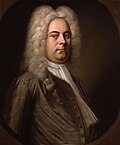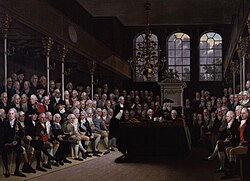Wig
A wig is an artificial covering of hair. The word is short for periwig and appeared in the English language around 1675. Some people wear wigs to hide the fact that they are bald, which means they have very little or no scalp hair. Actors often wear wigs to disguise their appearance or get into character. In Britain and other Commonwealth nations, some public employees, such as judges and barristers, wear wigs.
Many composers during the 18th century wore wigs.
Wolfgang Amadeus Mozart wearing a wig.
Johann Sebastian Bach wearing a wig.
George Frideric Handel wearing a wig.
A portrait by Nicolas de Largillière, a French painter. He painted a man with a wig.
Wig Media
Five Orders of Periwigs, 1761
William Pitt the Younger (standing centre) addressing the Commons on the outbreak of the war with France in 1793. Pitt and members of Parliament wore powdered wigs; in 1795 the Parliament passed the Duty on Hair Powder Act which caused the demise of both the fashion for wigs and powder.
United States Army officers wearing powdered wigs tied in a queue during the Treaty of Greenville negotiations in 1795
Historical reenactment of wig making in Colonial Williamsburg, Virginia










